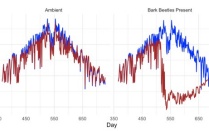Threats of Massive Forest Die-off in a Rapidly Changing Climate: How Do Biotic Attacks and Climate Change Affect Tree Mortality?
By katherine appleman, hamilton college
Advisors: Scott mackay, Geography, University at Buffalo
Advisors: james boyle, earth sciences, University at Buffalo
Project Objectives
Understand the role of defense costs on tree mortality in response to biotic stressors relative to other parts of the whole-plant system
Data and Results
•Plant Physiology, Soil and Bedrock Data, Climate Data
•rTREES and “Drought” server parallel runs
•64 forest simulations under varying environmental conditions including higher temperatures, higher CO2 levels, access to groundwater, droughts, bark beetle presence, and dry years.
Significance
•Addressing a gap in the understanding of the relative role of plant defenses against pests for tree mortality
•Current models used to predict tree mortality do not account for defense cost significance
Publication or Conference
------------------------------------------------------------------------------------------------
Center for Geological and Climate Hazards
Interdisciplinary Research Experience for Undergraduates in Atmospheric and Geological Hazards

Two plots showing a simulated forests under ambient conditions in the year 2015. Both plots show both a simulation which has access to ground water in blue, and one that does not in brown. The simulations in the plot on the right is under the same environmental conditions, expect that it also faces the biotic stressor of a Bark Beetle attack on day the 455 day of the simulation.